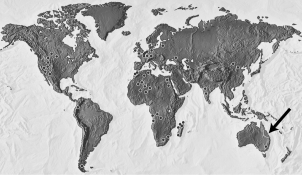Multiple Choice
In the figure below, the region indicated by the arrow is the only modern-day location of the freshwater lungfish. Fossils of the ancestors of the lungfish, however, have been found all over the world (dots throughout map) . What does the distribution of these fossils indicate? 
A) When Pangaea separated to form our continents, the living ancestors of the lungfish were separated. When they died, some of them formed fossils in their new lands.
B) The same species of lungfish evolved on all of Earth's major landmasses after continental drift had stopped.
C) The ancestors of the lungfish existed on Pangaea. After they died, some were fossilized. Their fossils were separated by continental drift.
D) Lungfish were much more successful in the climates of North America than they were in the climates of South America.
Correct Answer:

Verified
Correct Answer:
Verified
Q30: Which of the following is not likely
Q31: Biological evolution can be defined as<br>A)the process
Q32: A species of cave beetle that lives
Q33: According to the evolutionary tree below, the
Q34: Which of the following is not homologous
Q36: Pangaea is<br>A)the process of continental drift.<br>B)the combined
Q37: Nonheritable genetic changes can cause evolution within
Q38: A(n)_ is a characteristic of an organism
Q39: The result of _ over evolutionary time
Q40: Evolution can be described as<br>A)predesigned change in